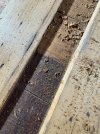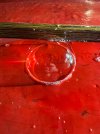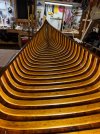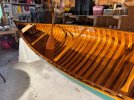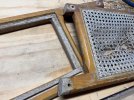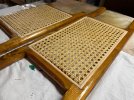You are using an out of date browser. It may not display this or other websites correctly.
You should upgrade or use an alternative browser.
You should upgrade or use an alternative browser.
old town canoe - wooden
- Thread starter macdouga
- Start date
Dave Wermuth
Who hid my paddle?
Two quarts should be plenty. I thin 50/50 for sealer. Then 75/25. then full strength. I sometimes will put clear shellac on first as a sealer.
MGC
Scrapmaker
Because he did not strip the hull, I would probably not use shellac in it although I do occasionally do that on my own canoes and specifically Rushton's. His best bet is going to be sticking with spar varnish. Hopefully the old fish was not poly. Time will tell.Two quarts should be plenty. I thin 50/50 for sealer. Then 75/25. then full strength. I sometimes will put clear shellac on first as a sealer.
MGC
Scrapmaker
When you described the sanding process to be difficult and that the varnish seemed gummy, that suggested the possibility. I am not sure how I can explain the difference to you. I can tell based upon many years of dealing with both. You can most certainly tell when poly fails due to water getting behind it. It tends to bubble and peel in layers. Spar will dry and flake, or alligator.
The uncertainty would keep me from using shellac. Thinned spar......
The uncertainty would keep me from using shellac. Thinned spar......
Last edited:
Michael Grace
Lifetime Member
Shellac is often called the universal finish because it can be used on top of or under most other finishes. It certainly can be applied over polyurethane. However, the flexibility of these two finishes is different, so there could be problems in the long term if there is movement caused by sun heating, hull flexing, etc. (both of which are to be expected during use). In any case, as MGC has indicated, polyurethane is a poor finish for wooden boats. It would be best to do whatever possible to get down to bare wood before refinishing, and you seem to be doing a good job at that.
I've been watching your posts from the beginning and given that you're so interested in doing well with this canoe, why not do a full restoration? It was a freebie and there's no family connection for you but even so, you seem to care about and respect this canoe. You might find it great fun to take it down to the bare hull and bring it back to original condition with proper materials. In the end you'll have a canoe that is in much better condition for use, and you'll have the satisfaction of knowing you did it.
I've been watching your posts from the beginning and given that you're so interested in doing well with this canoe, why not do a full restoration? It was a freebie and there's no family connection for you but even so, you seem to care about and respect this canoe. You might find it great fun to take it down to the bare hull and bring it back to original condition with proper materials. In the end you'll have a canoe that is in much better condition for use, and you'll have the satisfaction of knowing you did it.
macdouga
Curious about Wooden Canoes
if it helps, here's what the finish looks like, including where I've scraped it, so you can see the texture of what I've removed.When you described the sanding process to be difficult and that the varnish seemed gummy, that suggested the possibility. I am not sure how I can explain the difference to you. I can tell based upon many years of dealing with both. You can most certainly tell when poly fails due to water getting behind it. It tends to bubble and peel in layers. Spar will dry and flake, or alligator.
The uncertainty would keep me from using shellac. Thinned spar......
Attachments
macdouga
Curious about Wooden Canoes
My time with the canoe this summer is limited (hence the 5 a.m. start), but maybe in the future I’ll have the time and energy to strip off the fiberglass and get down to the bare hull. I’m certain there are planks that could benefit from being replaced. I have no idea how to go about canvasing and restoring that part of the canoe to its original condition, but I imagine it would be an interesting challenge.Shellac is often called the universal finish because it can be used on top of or under most other finishes. It certainly can be applied over polyurethane. However, the flexibility of these two finishes is different, so there could be problems in the long term if there is movement caused by sun heating, hull flexing, etc. (both of which are to be expected during use). In any case, as MGC has indicated, polyurethane is a poor finish for wooden boats. It would be best to do whatever possible to get down to bare wood before refinishing, and you seem to be doing a good job at that.
I've been watching your posts from the beginning and given that you're so interested in doing well with this canoe, why not do a full restoration? It was a freebie and there's no family connection for you but even so, you seem to care about and respect this canoe. You might find it great fun to take it down to the bare hull and bring it back to original condition with proper materials. In the end you'll have a canoe that is in much better condition for use, and you'll have the satisfaction of knowing you did it.
macdouga
Curious about Wooden Canoes
I'm making progress. before painting I thought I'd better check to see if the fiberglassing and epoxy had caught all the holes but I'd missed one. it was tough to find given all the potential spots, but I adjusted the vacuum so that it blows out, and had my wife sit under the canoe with the wand testing various spots while I put soapy water on the hull - found the culprit, but this delayed painting while the additional fiberglass/epoxy cures. however I did finish the scraping/sanding of the interior and put what I expect is the last coat of varnish on this morning. As recommended by Dave - I did 50:50, then 75:25, then 100:0. The character accumulated over 84 years was really brought out nicely with the finish. We are off to Temagami tomorrow to pick up my son from his adventure canoeing north to James Bay and then up the Moose River. There's a canoe company originally operating from there that you probably all know about.
Attachments
macdouga
Curious about Wooden Canoes
seems like this kit might be the way to go? https://hhperkins.com/products/cano...isZo25PVPz-plkTMnaoKrGQNMi4x_tc2DNemK8G2rlHze
MGC
Scrapmaker
You will probably get mixed feelings about that plastic cane. I have never dealt with it on any of my canoes, but I suppose it would be OK. It gives the appearance of proper cane.
Given a choice of that plastic weave, webbing, lacing, slats, lawn chair weave and all of the other things people use, I would certainly prefer something that looks period correct, as that does. I have no idea how well it holds up over time.
Given a choice of that plastic weave, webbing, lacing, slats, lawn chair weave and all of the other things people use, I would certainly prefer something that looks period correct, as that does. I have no idea how well it holds up over time.
macdouga
Curious about Wooden Canoes
Thanks for your thoughts!You will probably get mixed feelings about that plastic cane. I have never dealt with it on any of my canoes, but I suppose it would be OK. It gives the appearance of proper cane.
Given a choice of that plastic weave, webbing, lacing, slats, lawn chair weave and all of the other things people use, I would certainly prefer something that looks period correct, as that does. I have no idea how well it holds up over time.
macdouga
Curious about Wooden Canoes
Thank you for all your help everyone!!! There are still a few details for me to work on but here's my [more or less] final refurbishment of the 1941 Old Town. I'm back at work now, but when I get a chance I'll see if I can redo the old seats rather than use these new ones - that way the wood will match a bit better. It doesn't leak, and my students even caught a fish. The canoe would be in much worse shape than it is now without your guidance and experience, and I really appreciate all your insights.
Attachments
macdouga
Curious about Wooden Canoes
I hope someone is still out there following this thread as I could use some advice. I wasn't that happy with how the purchased new seats matched the canoe, and I was interested in how to recane the seats, so I stripped out the old caning, and tried my hand and adding new rattan. My question for you wise ones is how to best protect the new caning. I've read not to put spar varnish on it because it'll make it brittle, but I've also read to put it on, especially with a thinned first coat. I've also read boiled linseed oil or tung oil, with annual reapplications. Any advice out there on best practices?
Attachments
Years ago this question generated some heated responses in this forum. Old Town traditionally did not varnish their cane seats. The link below and others have more details. Your mileage may vary...
Benson
Benson
I finished re-furbishing the 1936 Old Town Yankee that had been fiberglassed, it turned out to be quite a job. There was a lot of bad fiberglasss on the boat that had to come off, and I wound up sanding my re-glass for two weeks straight to get it smooth enough to paint. Anyway, it came out looking pretty, I used some marine topside paint from Lowes to paint it, color dark green, looked like gel-coat when I got done. The only pictures I have are on a web page where I'm offering it for sale, so don't know if it would be kosher to post it here...
My reason for posting today is to ask if...
My reason for posting today is to ask if...
- Canoeguy
- Replies: 4
- Forum: Wood and Canvas
macdouga
Curious about Wooden Canoes
Thanks Benson! Very helpful. I'll do the top surface and see how how well it holds up. Life is full of experiments!Years ago this question generated some heated responses in this forum. Old Town traditionally did not varnish their cane seats. The link below and others have more details. Your mileage may vary...
Benson
I finished re-furbishing the 1936 Old Town Yankee that had been fiberglassed, it turned out to be quite a job. There was a lot of bad fiberglasss on the boat that had to come off, and I wound up sanding my re-glass for two weeks straight to get it smooth enough to paint. Anyway, it came out looking pretty, I used some marine topside paint from Lowes to paint it, color dark green, looked like gel-coat when I got done. The only pictures I have are on a web page where I'm offering it for sale, so don't know if it would be kosher to post it here...
My reason for posting today is to ask if...
- Canoeguy
- Replies: 4
- Forum: Wood and Canvas
Similar threads
- Replies
- 1
- Views
- 907
- Replies
- 1
- Views
- 1K
- Replies
- 3
- Views
- 2K

